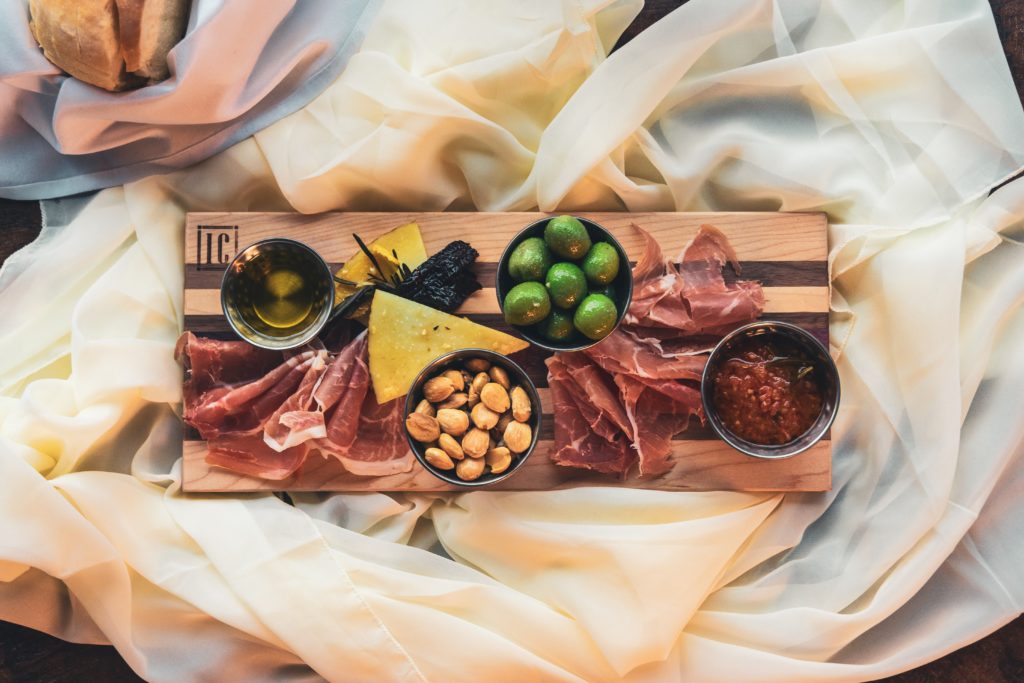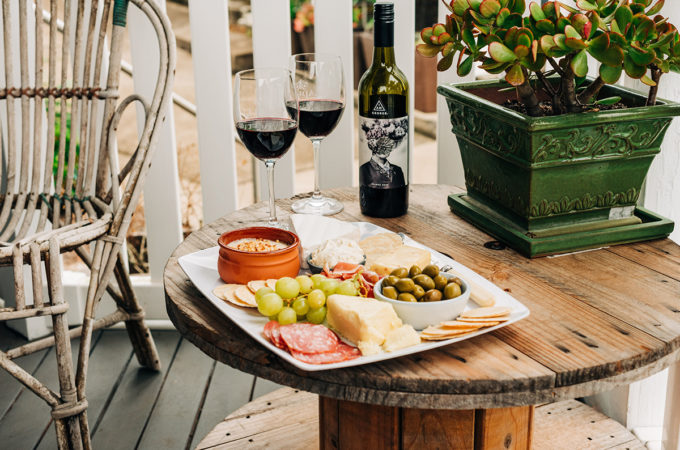Charcuterie board is one of the most recent food trends where cheeses, fruits, and meats are laid out on a wooden board for special occasions with the host’s intent to impress their guests. Dating back to the 15th century in France, Charcuterie is a “French term for a branch of cooking devoted to preserve meat products such as bacon, ham, sausage, terrines, galantines, ballotines, pâté, and confit, primarily from pork.”

At present, charcuterie boards have been adjusted so that not only a variety of meat products are included, but other components such as fruits, cheese, and crackers can be tasted as well. Before diving deep into your charcuterie board DIY, you need to get a cheese board to put all the ingredients. Wine Enthusiast has a wide range of selections, click here to find the perfect board, knives, and cheese grotto for display.
Next, moving on to the wines. For starters, there are a few kinds of wine that help combat saltiness and fattiness in meats. A bolder red wine, a high acidic red wine, or a crisp white wine would do the trick. Our Wine Director Josh Farrell has chosen some wines that would be perfect to pair with charcuterie boards!
Bold, Tannins Red Wines:
- Tardieu-Laurent 2018 Crozes Hermitage, Vieilles Vignes
- Vieux Telegraphe 2019 Chateauneuf Du Pape, La Crau
- Napanook 2019 Cabernet Sauvignon, Dominus Estate, Napa Valley
- Precision 2020 Cabernet Sauvignon, Napa Valley
High Acidic Red Wines:
- J.L. Chave Selection 2019 Cotes Du Rhone, Mon Coeur
- Giovanni Rosso 2016 Etna Rosso
- Terra D’Oro 2019 Deaver Vyd. 135 Year Old Vine Zinfandel, Amador
- Easton 2015 Zinfandel, Amador
Crisp White Wines:

With the cheese board and wines ready, you can start assembling your charcuterie board. To make a perfect charcuterie board, there are five basic elements.
1. Cheese
As the star of the charcuterie board, it is important to choose the cheese that has great taste and texture. Usually, a medium-size charcuterie board includes two hard and two soft cheeses. However, you can always increase or decrease the amount depending on personal preference.
2. Savory
Having one or two savory elements would provide a more balanced taste while pairing up meats and fruits. For example, olives, nuts (such as almonds, walnuts, pistachios, and pecans), cornichons, Southern Style Rustic Mustard, or Dijon Mustard are great choices!
3. Sweet
While many people may already know, fruits are also a huge element of charcuterie boards. Fresh fruits such as grapes, strawberries, raspberries, and dried fruits such as dried apricots break down the fattiness in the meats. You can also include honey, fig jams, and jellies as they go well with cheese.
4. Meat
Taking it back to its origin, most charcuterie boards have cured or fermented meats that are salty and fatty. Some commonly used meats are Prosciutto, Sopressata, Rillettes, Spanish chorizo, and salami.
5. Bread
An easier way to select your bread is to refer to your cheese and spread. To pair with softer components such as soft cheese, pâté, or fig spread, a harder bread like a baguette or crackers will act as great support.
Now that you’ve learned our tips about charcuterie boards and wine pairings, you can DIY and create endless combinations! What are some of your favorite charcuterie board and wine pairings?
References:
The Culinary Institute of America. Garde Manger: The Art and Craft of the Cold Kitchen. 3rd ed. Hoboken, NJ: John Wiley & Sons, 2008. ISBN 978-0-470-05590-8.
Shipman, S. (2017, June 11). The Five Elements of a Perfect Charcuterie Board. shannonshipman.com. Retrieved June 14, 2022, from https://shannonshipman.com/the-five-elements-of-the-perfect-charcuterie-board/
Dickerson, N. (n.d.). How to make a mouthwatering Charcuterie Board. Wine Folly. Retrieved June 14, 2022, from https://winefolly.com/wine-pairing/how-to-make-a-mouthwatering-charcuterie-board/


0 Comments